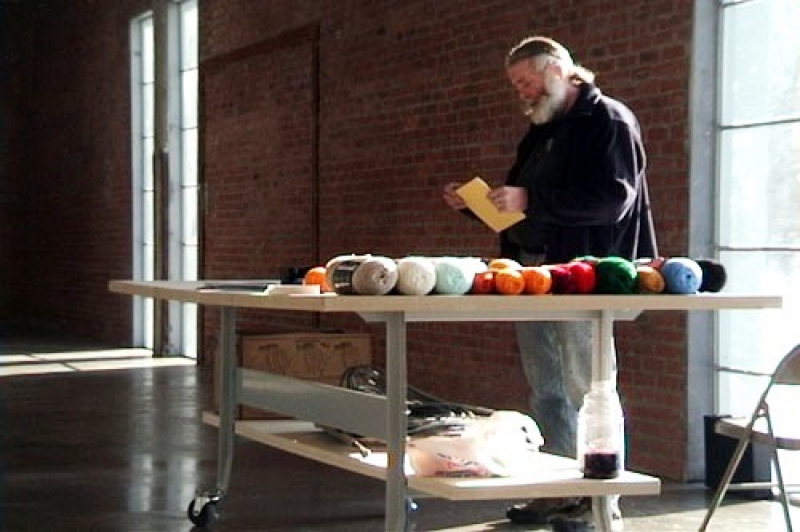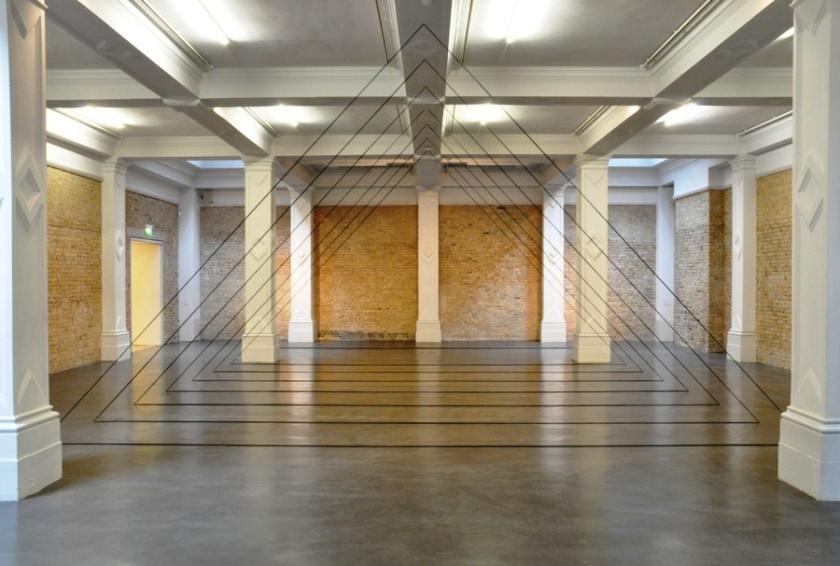Fred Sandback is one of the great overlooked of the Minimalist movement that developed in the 1960s. Both those words are important – “great” and “overlooked”: his work is genuinely great, and part of its greatness is the way it has overlooking built into it.
At its most basic, Sandback created geometrical shapes out of string (pictured below right: photo, Fred Sandback Archive). Using mostly an acrylic yarn, slightly fuzzy, and coloured as appropriate, Sandback “built” sculpture with volume but without mass, sculpture that, unlike traditional works, had no interior. Instead, the yarn builds and creates shapes out of air, using the architecture of the room it finds itself in, the floors, ceilings and walls, as pivots, literal as well as figurative.
Untitled (Sculptural Study, Seven-part Triangular Construction) (main picture, above) occupies most of the old reading room in the Whitechapel, its relatively low ceiling, mellow brick walls and pillars frame seven triangles made from black yarn, their points attached to the ceiling, the corners at the floor pin-sharp and slicing the air. As the viewer walks along the side, the crossing and uncrossing of the angles of the triangles fold and unfold in a prism.
In this piece, as in all Sandback’s work, the illustrative, pictorial nature of sculpture is blown apart. “Fact and illusion are equivalents,” Sandback wrote. “Trying to weed one out in favour of the other is dealing with an incomplete situation.” And here, the incomplete and even contradictory nature of our diametrically opposed beliefs – that representation is a true kind of difference, or a different kind of true, is laid bare.
 It is fascinating to watch others look at a Sandback. Rarely is anyone willing to walk through the space delineated by the yarn, so strong is the sense of volume that has been created by these few bits of string. The people who do walk through it do it with an air of self-conscious bravado, even defiance, as if they expect to hear the sound of tinkling glass as they shatter an invisible pane.
It is fascinating to watch others look at a Sandback. Rarely is anyone willing to walk through the space delineated by the yarn, so strong is the sense of volume that has been created by these few bits of string. The people who do walk through it do it with an air of self-conscious bravado, even defiance, as if they expect to hear the sound of tinkling glass as they shatter an invisible pane.
Sandback’s pieces have an even more ephemeral, even episodic, existence than most sculpture. Installing a piece means reassessing ceiling and floor dimensions, recreating “corners” around which the strings curve.
Broadway Boogie-Woogie (Sculptural Study Twenty-part Vertical Construction), named of course for Mondrian’s famously unboogie-ish checkerboard, becomes, in the Whitechapel’s space, a glinting waterfall of blue, yellow and red strings, depending from a skylight and thus a river of colour running down a shaft of light. Three small corner pieces, so demurely tucked away that it is easier to look first for the label, and only then locate the sculpture, make their blue, DayGlo orange and violet presences felt by “building” in space corners of the room that do not exist.
This small exhibition has three vitrines displaying photographs of earlier Sandback pieces, and given the relative paucity of Sandback’s works in public collections compared to his peers like Donald Judd (Dia:Beacon in upstate New York being the main exception), it is useful to have the documentation. But a Sandback work is a small shimmering miracle of Minimalist formality and beauty – no photograph can capture the bizarrely illusionistic spell woven by this magician of non-illusionism.









![SEX MONEY RACE RELIGION [2016] by Gilbert and George. Installation shot of Gilbert & George 21ST CENTURY PICTURES Hayward Gallery](/sites/default/files/styles/thumbnail_125_x_125_/public/mastimages/Gilbert%20%26%20George_%2021ST%20CENTURY%20PICTURES.%20SEX%20MONEY%20RACE%20RELIGION%20%5B2016%5D.%20Photo_%20Mark%20Blower.%20Courtesy%20of%20the%20Gilbert%20%26%20George%20and%20the%20Hayward%20Gallery._0.jpg?itok=3oW-Y84i)





Add comment